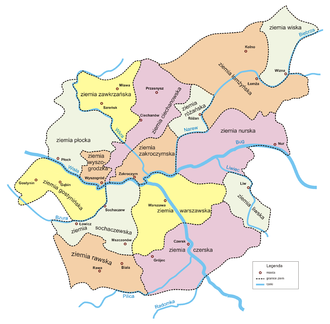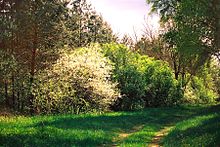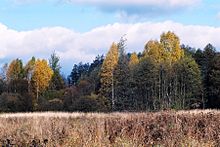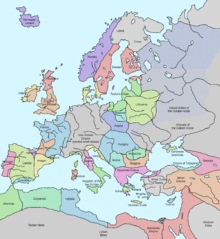- Mazovia
-
Mazovia or Masovia (Polish: Mazowsze) is a geographical, historical and cultural region in east-central Poland. It is also a voivodeship (an administrative region) in Poland.
Its historic capital is Płock,[1] which was the medieval residence of first Dukes of Masovia. Different capitals of individual former duchies of Mazovia also include Czersk and later Warsaw.
Contents
Geography
Mazovia is a low-lying region. To the north is the Mazovian Lowland; to the east, the South Podlasian Lowland; and to the south, the Iłża Foreland. The Mazovia region is spread over the Masovian Plain on both sides of the Vistula river and its confluence with the Narew. In the north Mazovia borders on the Masurian region of former Old Prussia, in the east on Podlachia, on Lesser Poland in the south and Greater Poland in the west. In the northwest, the Duchy of Kuyavia split off Mazovia in 1233. Administrative borders of the contemporary Masovian Voivodeship do not follow historical and cultural lands of Mazovia. For example, the city of Łomża belongs instead to the Podlaskie Voivodeship; Skierniewice belongs to Łódź Voivodeship; while Radom, historically part of Lesser Poland, is now, however, a part of the Masovian Voivodeship.
The main rivers are the Vistula (Wisła), Bug, Narew, Pilica, and Wkra. Forests (mainly coniferous) cover one-fifth of the province. The climate is characterized by warm summers and cool winters. Average annual precipitation is 20–24 inches (500–600 mm). Two-thirds of the province’s residents live in cities, with Warsaw being the centre of the largest conurbation in Poland. Other large cities include Radom, Płock, Siedlce, Ostrołęka, and Pruszków.
History
The historic region of Mazovia (Mazowsze) was situated astride the middle course of the Vistula River. The historical capital of Mazovia is Płock, being the oldest town this region. It received its town rights in 1237. It is the former residence of the Mazovian princes. It is the oldest legislated seat diocese of Mazovia, established in 1075. The Płock Cathedral was built in the first half of the XII century, in which the royal chapel is situated together with the sarcophagus of Polish monarchs. The cathedral in Płock is one of five oldest Polish cathedrals. Between 1079 – 1138 Płock was the capital of Poland. He performed this function in times Polish monarchs: Władysław I Herman and Bolesław III Krzywousty. In the period of the rule of the first monarchs of Piast State, like also before Baptism of Poland - 966 year, in the X century Płock as the capital castle were one of monarchal seats, among others of prince Mieszko I and of king Bolesław I Chrobry, which on the Płock Tumskie Hill raised one's palatium. However in years: 1037-1047 Płock was capital of the independent, Mazovian state of Masław.
During the 9th century it was inhabited by the Mazovian tribe, and it was incorporated into the Polish state in the 10th century under the Piast ruler Mieszko I. In 1047, following a period of upheaval, it was reannexed to Poland by Casimir I. In 1138 the duchy of Mazovia was established, and during the 12th and 13th centuries it endured Prussian, Jatvingian, and Rus invasions. To protect its northern section Conrad of Mazovia called in the Teutonic Knights in 1229 and granted them the Chełmno Land. After the reunification of the Polish state by Władysław I in the early 14th century, Mazovia retained independent status. In 1529 Sigismund I incorporated Mazovia (with its main stronghold in Warsaw) into the Polish state.
For more details on this topic, see Duchy of Mazovia.During the 15th and 16th centuries the region began exporting grain, timber, and fur. The Polish-Lithuanian Union of Lublin (1569) established Mazovia as the central region of the Polish-Lithuanian Commonwealth, with Warsaw rising to prominence as the seat of the state legislature. In 1596 King Sigismund III Vasa moved the Polish capital from Kraków to Warsaw. During the 17th and 18th centuries Swedish, Transylvanian, Saxon, and Russian invasions wreaked havoc on the region. With the last of the Partitions of Poland (1795), the northern and western sections of the area became part of Prussia, with the remaining portion annexed to Austria. In 1815 the region was incorporated into the Congress Kingdom of Poland, which was dependent on Russia. In the mid-19th century Mazovia was the site of Polish rebellions against Russian rule. The latter part of the 19th century saw rapid development of agriculture, the food, metal, and textile industries, and railway transport. At that time the Warsaw Industrial District was exporting the majority of its products to Russia. Under the German occupation of Warsaw during World War II, the city’s population decreased sharply as a result of executions, the extermination of the city’s Jews, the deaths of some 200,000 inhabitants during the Warsaw Uprising of 1944, and the deportation of the city’s left-bank population following the uprising. Shortly after the uprising, German Chancellor Adolf Hitler ordered Nazi troops to destroy the city. The rebuilding of the Polish capital was the main task of the postwar period.[2]
In 1999 the Masovian Voivodeship was created as one of 16 administrative regions of Poland. It is the biggest voivodeship of the country.
People
Folk costumes from Łowicz Folk costumes from Kurpie region
Folk costumes from Kurpie region For more details on this topic, see Masovians.
For more details on this topic, see Masovians.Masovian dialect
For more details on this topic, see Masovian dialect.The Mazovian language existed as a separate dialect well until 20th century.[3][4][5][6][7][8] In the process of mixing the Polish and the Mazovian speeches, the Mazovian dialect emerged within the Polish language.
Economy
At the turn of the 21st century, Masovian Voivodeship ranked first among Poland’s provinces in total value of industrial output and in amount of investments made by foreign sources.[9] Warsaw is the financial capital of Poland and Central Europe.[10][11]
Industrial activity is centred in the Warsaw Industrial District, which includes Warsaw, Płock Pruszków, Żyrardów, Piaseczno, Ożarów, Sochaczew, Grodzisk Mazowiecki, Legionowo, and Mińsk Mazowiecki. The majority of state enterprises are headquartered in Warsaw. Leading industries in the city include automobile manufacturing, steel production, food processing, and business services. Other industrial centres are Płock, where large petrochemical plants PKN Orlen operate, and Radom, which has a large munitions factory. Kross, the greatest producer of bikes in Europe has its headquarters in Siedlce. In Mińsk Mazowiecki Przedsiębiorstwo Budowy Dróg i Mostów is located. In the same city, ZNTK "Mińsk Mazowiecki" has its headquarters. Even though the province is highly industrialized, two-thirds of it is farmland, and Masovian Voivodeship is a leading producer of potatoes. Other major crops are rye, sugar beets, fruits, and vegetables. Warsaw is a hub for both rail and vehicular traffic, with access throughout Poland and across Europe. A river port on the Vistula operates in Płock. Warsaw Chopin international airport, in a southern subdivision of Warsaw, is the nation’s busiest.
Tourism
Kampinos National Park is one of Poland’s largest national parks and is popular with tourists making day trips from Warsaw to hike among the park’s primeval forests, sand dunes, and marshland. The main cultural centre of the province, and, alongside Kraków, in all of Poland, is Warsaw, which is home to dozens of theatres, the National Philharmonic, the National Opera House, the National Library, and the National Museum. Warsaw has many magnificent historic buildings and monuments, including those in the Old Town (founded at the turn of the 14th century) and the New Town (begun in the 15th century), both of which were almost completely demolished during World War II but were meticulously restored and were designated UNESCO World Heritage sites in 1980. Historical monuments elsewhere include the manor house in Żelazowa Wola where composer Frédéric Chopin was born and that today contains the Chopin Museum. Płock, once the seat of the Mazovian and Płock princes from the 12th to the 15th century, is noted for its Renaissance cathedral.[12]
Mazovian cuisine
There is no specific regional cuisine of Mazovia. Formerly, dairy foods dominated the peasant cuisine. Nobles used poultry, geese, chickens, ducks. Most separate Mazovian culinary region's is Kurpie and Łowicz, where traditional dishes have survived until to the present day. In Kurpie traditional dishes are prepared with ingredients collected in the forest: berries, honey and mushrooms. There are several dishes traditional Polish dishes, e.g. flaki, kluski, which are prepared in different way than in other parts of Poland.[13][14]
Galeria
See also
- Świdermajer – an architectural style in the area
References
- ^ Mazowsze: Obraz Etnograficzny, Volume 1, by Wojciech Gerson and Oskar Kolberg, BiblioBazaar, 2009 - 372 pages
- ^ http://www.britannica.com/EBchecked/topic/659713/Mazowieckie
- ^ http://www.archive.org/stream/historyauniwers00moragoog/historyauniwers00moragoog_djvu.txt
- ^ http://www.polona.pl/Content/863/ocr.txt
- ^ http://books.google.co.uk/books?id=hBIEAAAAYAAJ&dq=jezyk%20mazowiecki&pg=PA504#v=onepage&q&f=false
- ^ http://www.archive.org/stream/kopernikijana00polkgoog/kopernikijana00polkgoog_djvu.txt
- ^ http://books.google.co.uk/books?id=0cQaAAAAYAAJ&dq=jezyk%20mazowiecki&pg=PA327#v=onepage&q&f=false
- ^ http://www.archive.org/details/mitteilungen01masogoog
- ^ Mazowsze jest i będzie najbogatsze w Polsce
- ^ Warsaw: Central Europe's Bourse to Beat - BusinessWeek
- ^ Warsaw makes bid to become Central Europe’s financial hub – Taipei Times
- ^ Mazowieckie
- ^ Kuchnia Mazowsza i Kurpiów – Kuchnia Polska
- ^ Potrawy mazowieckie – Kuron.com.pl
Categories:
Wikimedia Foundation. 2010.



















